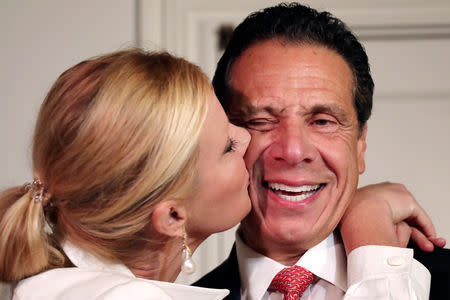Victorious Cuomo confronts changing Democratic landscape
By Jonathan Allen and David Gaffen
(Reuters) - Andrew Cuomo heads into November the heavy favorite to win a third term as New York's governor, en route to what some believe are presidential aspirations come 2020. But on his way there, the ground has shifted under his feet.
The incumbent Democrat spent $18 million to hold off an aggressive challenge from actress and political novice Cynthia Nixon in a bitter nominating contest. Along the way, he shifted to the left, agreeing to restore voting rights for parolees and moving closer to marijuana legalization.
However, he may have more work to do as the Democratic Party nationwide increasingly aligns itself with priorities like increased ballot access and single-payer healthcare, and as some remain skeptical of Cuomo's recent shift.
"If he wants to have a chance in a Democratic primary, as Democratic voters really turn to the left, he’s going to have to lay out some progressive credentials," said Patrick Egan, a politics professor at New York University. Cuomo has denied he will run for president in 2020.
While Cuomo won easily against the inexperienced Nixon, the active challenge to his left nearly cost him his lieutenant governor, Kathy Hochul, who held off an unexpectedly strong challenge from an insurgent candidate.
It also resulted in losses for several Democrats in the state Senate who for years had caucused with Republicans, giving that party control of the state's upper chamber - an arrangement that made many skeptical of Cuomo, a wariness not necessarily assuaged by his recent efforts on policy.
"Everything 'left' that he's done is basically because Cynthia pushed him to do it," said Mindy Rosier, a 43-year-old public school special education teacher from Manhattan and a Nixon supporter.
The election of President Donald Trump has proved a call to action for voters on the party's left flank. Voters nominated more liberal candidates to represent Democrats for governor's races in Florida and Georgia, but the movement has been seen in more conservative states as well.
Teachers went on strike in Oklahoma and West Virginia earlier this year in efforts to secure higher pay - and voters later defeated some lawmakers who voted against those efforts in Oklahoma's state contests.
"One of the things I’ve been most struck by is how the reaction to Trump has so deeply affected state-level contests, even at the district level," said Grant Reeher, professor of political science at Syracuse University’s Maxwell School of Citizenship and Public Affairs.
In New York, progressive anger was centered in the challenges to Democratic state senators who had handed the state's senate majority to Republicans. Several of those incumbents lost on Thursday. It was part of an effort by Democrats to regain power at the state level after suffering dramatic losses in states during the Obama Administration.
"Senate Republicans have held New York back for too long, and the oncoming blue wave will elect a functional Democratic majority in November," said Andrea Stewart-Cousins, the senate minority leader, who supported the Democratic challengers.
Having a more liberal senate may help Cuomo, experts said. The governor said that "nobody has stood up to Donald Trump like I have" at a debate last month, and New York was not immune to the surge in voter turnout among Democrats seen across special elections and nominating contests in the last year.
Nearly 1.5 million Democrats voted in Thursday's nominating contest, compared with less than 600,000 in 2014.
"He was able to effectively run against Washington and the Trump administration, messaging that may have helped draw energy from Democrats eager to participate in elections this year to check the President," said Daniel Lewis, associate professor at Siena College.
(Reporting by Jonathan Allen and David Gaffen; Editing by Christopher Cushing and Jeffrey Benkoe)




